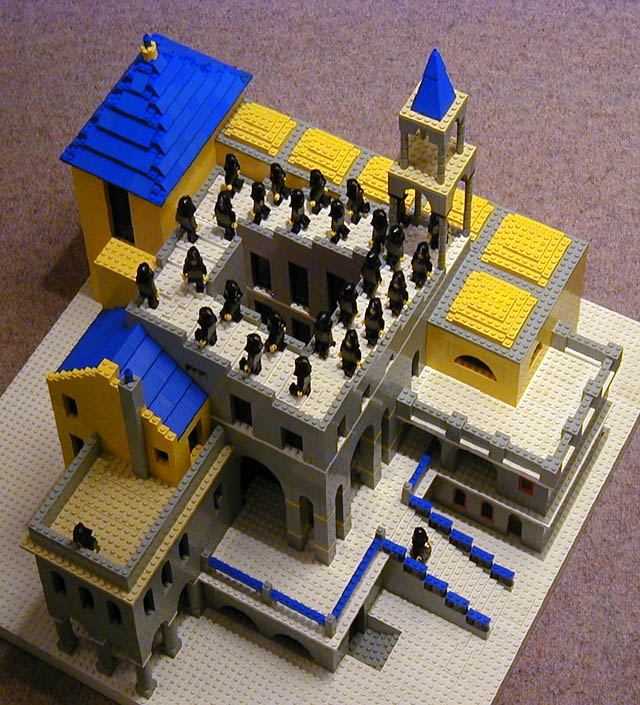
Because The LEGO Company get paranoid about this sort of thing let me make it clear that I have no affiliation with them, that my views are my own and do not necessarily represent theirs, and so on. So if you think any of this is official you are as deluded as they are.

Daniel Shiu and I worked on this as a joint project after we finished our rendition of Escher's "Belvedere", making it our third Escher picture rendered in LEGO (the first one was "Balcony"). No camera tricks, but the picture has to be taken from exactly the right place, and the final photograph was slightly distorted to emphasise the perspective effect. The original Escher picture is shown on the right for comparison. I'm especially pleased with the way the roof in the top left of the picture came out. Although I was able to use 45 degree roof bricks for the slopes on the long sides of the rectangle, the slope didn't match either these or the shallower roof bricks produced by LEGO. In the end I constructed the slopes on the short sides by putting a layer of plates in between each layer of shallow-sloped roof bricks. All very well, but almost anything you try along the lines where adjacent sides of the roof meet looks awful. I think it's come off quite well, all things considered. The project spent a few days in limbo while we waited for a couple of Bricklink orders (most of the black cowls came in one of these, and the steep blue corner slope pieces used ontop of the turret thing on the corner of the stairs came in the other). |
|
.
|
|
|
|
|
|
Finally, after taking the photograph, we distorted it slightly (stretched vertically and compressed the bottom very slightly) to emphasize Escher's slightly unreal perspective. While this wasn't from the constructional point of view our most ambitious project (that honour goes to "Balcony" which took several months to complete) it is probably the most visually effective so far.
All M. C. Escher works (C) Cordon Art, Baarn, the Netherlands. All rights reserved. Used by permission. The official M.C. Escher web site is worth a visit. In particular they have a "virtual ride" through "Ascending and Descending".
All other pictures on this page are Copyright © A. Lipson 2002.
LEGO ® is a trademark of The LEGO Group, who have nothing to do with this or any of my other LEGO-related web pages.
Back to ASL's home page
Back to ASL's LEGO page
Hits since 18 September 2002:
|
Powered by counter.bloke.com
This page last modified 1st April 2005